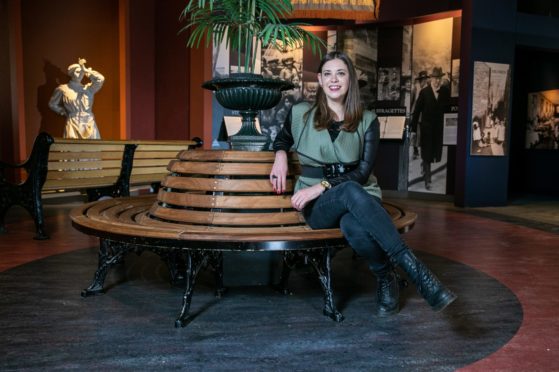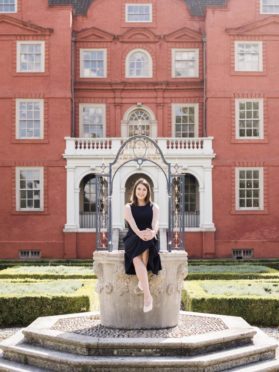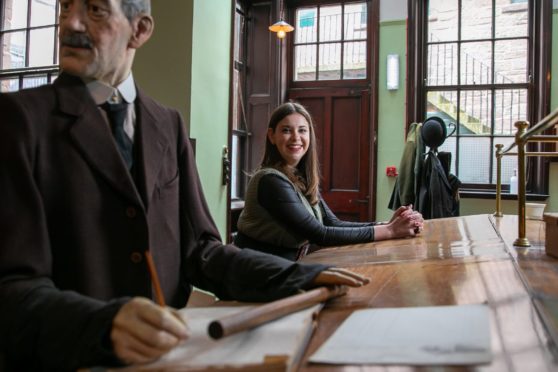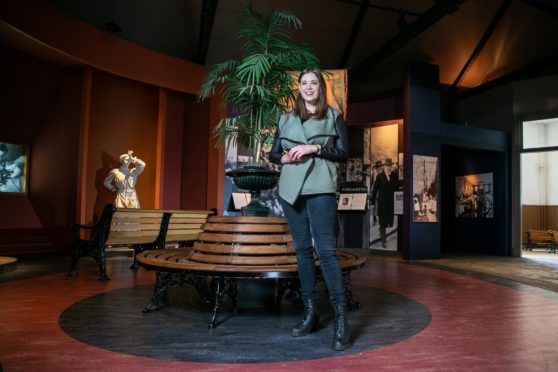From the working-class past of Dundee, Rachel Mackay has found herself in the rarefied surroundings of Georgian England, all for the love of history.
The former Harris Academy pupil was raised close to Balgay Park and now spends her days among the beautifully manicured Kew Gardens, home to the Kew Palace, where she is manager.
Not only does Rachel have responsibility for managing the four royal buildings, she has also been nominated in the Covid Special Recognition category in this year’s Museums and Heritage Awards.
Her blog The Recovery Room has been praised for bringing together useful resources to help museums and heritage sites prepare for reopening and share their experiences of lockdown.
The Recovery Register on the site is a list of useful contacts for anyone in the sector to reach out and support one another with a range of skills and experience.
It’s a long way for Rachel, who, at 15 started volunteering at Verdant Works in the café.
“I always had an interest in history and heritage but at this time I was just looking for a weekend job. When Verdant Works came up it was ideal. I could get some experience but also do something I really enjoyed.”
When we talk, Rachel just happens to be in Dundee and was delighted to get back into Verdant Works before its official reopening.
“I come back as often as I can. It’s amazing how things have grown in Dundee since I left. The city is so well served for attractions in such a small space.”
Making history from a young age
From Verdant Works, Rachel went to Dundee Science Centre (then Sensation) where she worked for part-time for six years, at school and during her time studying Medieval History at St Andrews University.
“I also volunteered at the castle there so was studying medieval history in and out of the castle! After graduation I did a graduate trainee programme offered by the then-Sensation. It gave me loads of experience in roles across running a visitor attraction.”
But following the training, roles in the heritage sector were thin on the ground and in 2008, Rachel headed to the home of historic attractions, London.
“I slept on a friend’s couch for a while. My first job was working at Madame Tussaud’s. One of my jobs early every morning was opening up the Chamber of Horrors – that was pretty terrifying!”
From scary wax murderers to dinosaurs, Rachel moved to the Natural History Museum, which she describes as “a university for visitor attraction managers”.
“It was an assistant manager’s job but over the eight years I was there I did so many different roles and ended up managing the whole visitor operation. When you consider that the Natural History Museum would normally have 25,000 people coming through a day it’s a huge responsibility.”
My first job was working at Madame Tussaud’s. One of my jobs early every morning was opening up the Chamber of Horrors – that was pretty terrifying!”
In 2017, Rachel moved to Historic Royal Palaces at Kew as manager.
“I’ve always had a huge interest in history but this was Georgian rather than medieval. I had a few months to do my homework before we opened for the summer season.”
Kew Palace was the family home of George III and the more Rachel learned, the more she wanted to communicate the real story about the king’s mental illness.
“The film The Madness of King George was great but generally in popular culture, whether it’s Blackadder or Hamilton, George is always depicted as as a joke, because he has always had this ‘madness’ surrounding him.
“There’s no way we would talk about people with mental health problems like that now.”
To that end, Rachel has always felt it’s Kew’s responsibility to let people understand the problems that George faced and in an exhibition opening on June 4, called The Mind Behind The Myth, there’s a look at the treatment he received through contemporary eyes.
Revealing the man behind the myth
“When I first arrived I wondered why we weren’t highlighting the fact that the huge story behind George III’s life and reign is his poor mental health. I’ve found that when visitors come it makes him more relatable and it allows them to open up about how it impacts on their own lives.
“The exhibition has been in the planning for a few years now, and of course it was installed and ready to go last year. We had the team coming in on the Monday for training but on the Friday that was it. We were closed – and we haven’t opened again at all in 18 months.”
3 weeks today we reopen #KewPalace with a new exhibition exploring the mind behind the myth of George III 💭
No one should be defined by their symptoms, yet George’s legacy has been eclipsed by his poorly understood struggles with mental illness (1/3)#MentalHealthAwarenessWeek pic.twitter.com/QkAzAQtk3z
— Historic Royal Palaces (@HRP_palaces) May 14, 2021
During lockdown, Rachel’s deputy manager would attend the palace and make checks because they lived so much closer but eventually she knew that a move from Clapham to nearer Kew would be necessary.
‘Furlough did not suit me’
“Being furloughed did not suit me one little bit,” she says. “I tried to stay engaged with the sector and did every webinar I could find.
“I was also doing a Masters but ended up having to change subject and made it about how museums and heritage sites were crisis managing during Covid-19.”
Generally in popular culture, whether it’s Blackadder or Hamilton, George III is always depicted as as a joke, because he has always had this ‘madness’ surrounding him.”
Rachel’s research led to some findings that she wanted to share with the wider museums and heritage community and The Recovery Room blog was born.
“I ended up helping people with their plans for reopening. I needed a place to put all these resources and the blog seemed to be a place to bring it all together.
“There was a guide about bringing front of house staff back to work safely. There were videos looking at areas such as conflict when visitors refused to wear a mask. It all grew from there.”
She adds that the museums and heritage world is supportive and there’s no secrecy is there’s a call saying “how many visitors did you get yesterday?”. They know that they’re stronger working together. The nomination was a surprise, however.
“I was delighted, primarily to represent Historic Royal palaces as I’ve been once before with them and we were runner-up. I really don’t think I’ll win as Bernard Donoghue, the Director of ALVA (Association of Leading Visitor Attractions) is in there but it’s great to get the nomination.”
Rachel’s category is open to public vote, however, so cast your vote on the website here before Friday, May 28.



